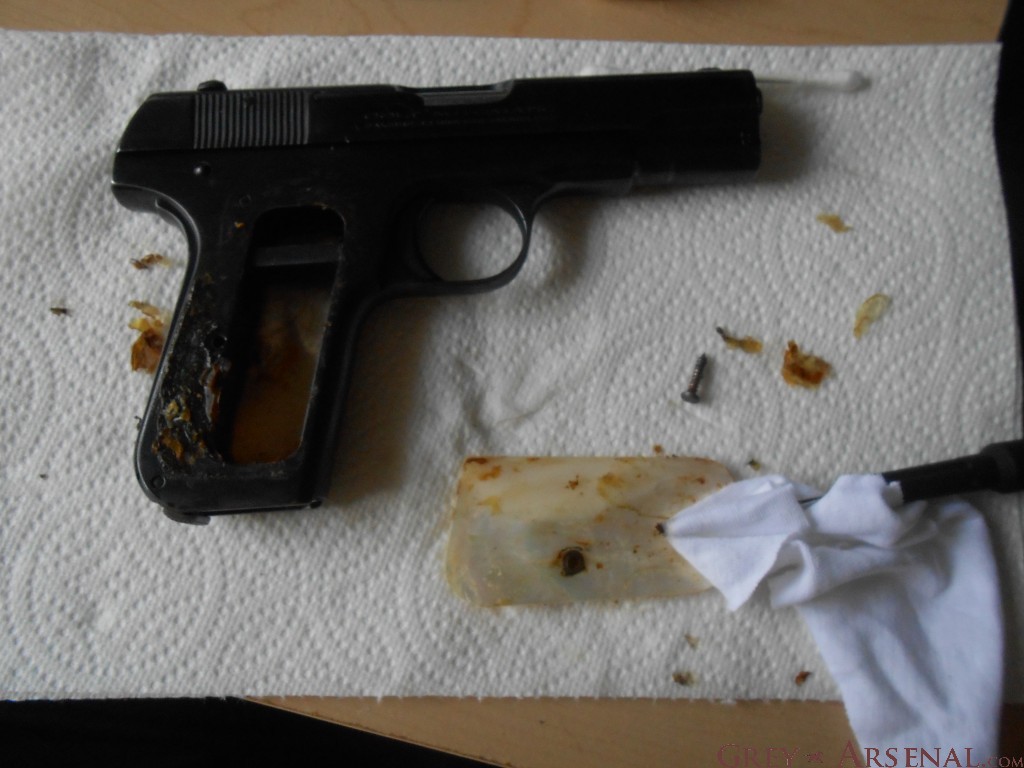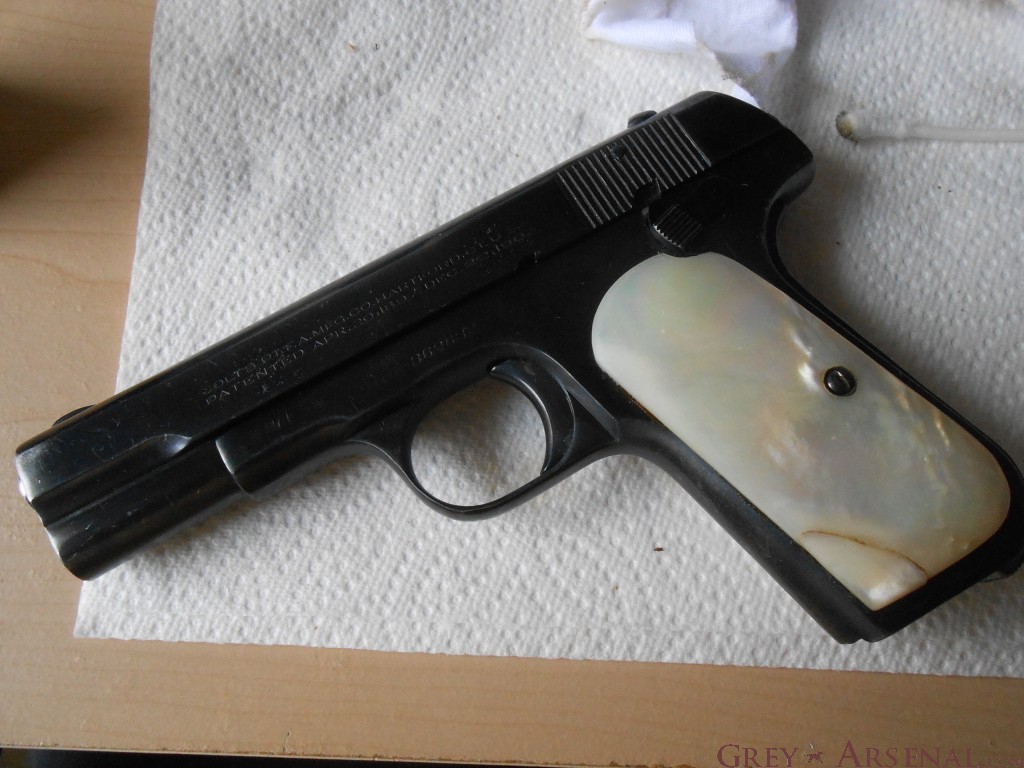Well, I intend to do a more in depth review and teardown guide on this handgun, but since an issue came up that required a quick fix, I thought I’d document and share.
First some background on this firearm. This little Colt is yet another marvel of turn-of-the-century design by John Moses Browning, predating the 1911 by a couple of years, but sharing some design features and having ergonomics very similar to the later Colt Government. Though mechanically different (striker vs. hammer), you can see the relation between this handgun and the FN 1910/22, a later model by the same legendary designer (which I’ll be featuring at a later time). This was basically the one of the first Concealed Carry autoloaders, with a very slim profile, “hammerless” (internal hammer) so as to not snag, low-profile rounded sights, and higher capacity and more firepower than an equal sized revolver. This role was well embraced by characters throughout history such as Al Capone who was said to always have one in his coat pocket, and Bonny used one to break Clyde out of jail by getting one in taped to her thigh. John dillinger was carrying one when he was shot by the FBI, and those very agents that shot him were likely carrying these as BUGs. This didn’t go unnoticed by the government either, and the OSS and later CIA used these as concealed carry guns all the way until the 1970s.
Anyhow, if there’s interest, I’ll go into more detail in a later post. As for this one, the S/N puts it’s production in 1920, making it a type III. It’s my significant other’s current favorite range gun, because it fits her tiny hands perfectly, is lightweight, firing a lightweight but still useable round (.32 ACP / 7.65, get the Fiocci, europeans load it hot), and it’s got that extra bit of history and panache that her Colt Government lacks. …part of which led to our problem.
I like to imagine this thing was carried by a gangster in the roaring 20’s, as it was ordered from Colt with custom mother-of-pearl grip panels. Unlike the wooden or hard rubber grip panels of the period, these were simply flat backed, and didn’t have a raised area that fit into the frame. This meant that simply screwing them in would not hold them in place, so they were glued in place. I’m not quite sure what kind of glue was used on firearms furniture in the 1920’s, but I do know that they clearly weren’t taking into consideration how disgusting and inconvenient it would be to future owners in 90 years. After this piece of history’s long slumber was awoke by the report of several hundred Fiocci 7.65 FMJ rounds, the glue decided to finally give out, forcing me to clean and reattach the grips.
Now… this may not be the BEST way to handle this as I was risking the finish under those grips, but this thing’s no museum piece so I wasn’t going to baby it, the main concern was getting the grips back on and still in one piece, and making sure they’d stay that way for a couple more decades.
After unscrewing and GENTLY rocking them back and forth, freeing from the remaining glue, both the grips and frame needed that ancient gunk removed. Enter my new best friend (which will be featured in the next post about proper cleaning supplies), Mil-Comm MC25, sprayed on the back of the grips and on the frame and allowed to soak for a bit.
A makeshift scraper out of a cloth-wrapped mini flathead and some (very careful) elbow grease later, and that evil crud has been removed. It didn’t bind very well to the pearl, and was very easy to remove (practically wiped off with cloth after the MC25 got to it). I’d have preferred to use a wooden or plastic scraper of some sort, but with the effort required to get some of this buildup off, it would’ve likely bent or cracked. I still managed to get this stuff off with minimal scratching to the finish, all in areas that will be covered by grips anyway. Just to be a bit anal and not want to leave unprotected scratches, even under the grips, I filled in the couple scratches I did make with a Birchwood Casey Presto Gun Blue Touch-Up Pen
(sorry, not pictured, stopped taking pictures at the point that I had funky old glue residue on my hands).
A fine bead of Locktite Super Control Gel and 2 screws later, and we’re back in business. I’ll be sure to update with how well this holds up, but I’d like to think that super glue technology has gotten better in the last century.
(Also, regarding this last picture, I never really noticed the difference in grip size on either side, odd. It does fit the hands really well though, and I’ve been told they’re at least period correct if not originals, so I’ll just chalk up another one to turn-of-the-century ergonomics)






very interesting! good job!